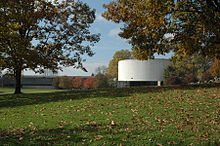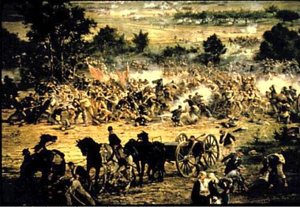- Gettysburg Cyclorama
-
The Battle of Gettysburg (detail) Artist Paul Philippoteaux Year 1883 Dimensions 8.2 m × 109 m (27 ft × 359 ft) The Battle of Gettysburg, also known as the Gettysburg Cyclorama, is a cyclorama painting by the French artist Paul Philippoteaux depicting "Pickett's Charge", the climactic Confederate attack on the Union forces during the Battle of Gettysburg on July 3, 1863. Four versions were painted, two of which are among the last surviving cycloramas in the United States.[1]
The first version of the painting, completed in 1883 and originally exhibited in Chicago, was lost for some time. It was rediscovered in 1965 and purchased by a group of North Carolina investors in 2007 for an undisclosed amount. Until November 2005, the second painting, originally exhibited in the Cyclorama Building in Boston, was on display at the Gettysburg National Military Park. It was removed for restoration work[2] and the exhibition was reopened September 2008 in the new Gettysburg National Park Museum and Visitor Center. The third version, exhibited in Philadelphia, is known to have been destroyed. The location of the fourth version, originally exhibited in Brooklyn, is unknown.
Contents
Description
The painting is the work of French artist Paul Dominique Philippoteaux. It depicts "Pickett's Charge", the failed infantry assault that was the climax of the Battle of Gettysburg. The painting is a cyclorama, a type of 360° cylindrical painting. The intended effect is to immerse the viewer in the scene being depicted, often with the addition of foreground models and life-sized replicas to enhance the illusion. Among the sites documented in the painting are Cemetery Ridge, the Angle, and the "High-water mark of the Confederacy".[1] The completed original painting was 22 feet (6.7 m) high and 279 feet (85 m) in circumference.[3] The version that hangs in Gettysburg, a recreation of the original, is 27 feet (8.2 m) high and 359 feet (109 m) in circumference,[1] although that version has lost some of its size due to the ravages of time. Its original size is estimated at 42 feet (13 m) high and 365 feet (111 m) in circumference.[4]
Development
 Philippoteaux painting the Gettysburg Cyclorama. The officer depicted on the far right, holding a sword in front of the tree, is an image of the artist, included in the painting as a hidden "signature".[5]
Philippoteaux painting the Gettysburg Cyclorama. The officer depicted on the far right, holding a sword in front of the tree, is an image of the artist, included in the painting as a hidden "signature".[5]
Philippoteaux became interested in cycloramas and, in collaboration with his father, created The Defence of the Fort d'Issy in 1871. Other successful works included Taking of Plevna (Turko-Russian War), the Passage of the Balkans, The Belgian Revolution of 1830, Attack in the Park, The Battle of Kars, The Battle of Tel-el-Kebir, and the Derniere Sortie.[5] He was commissioned by a group of Chicago investors in 1879 to create the Gettysburg Cyclorama. He spent several weeks in April 1882 at the site of the Gettysburg Battlefield to sketch and photograph the scene, and extensively researched the battle and its events over several months. Local photographer William H. Tipton created a series of panoramic photographs shot from a wooden tower erected along present-day Hancock Avenue. The photos, pasted together, formed the basis of the composition. Philippoteaux also interviewed several survivors of the battle, including Union generals Winfield S. Hancock, Abner Doubleday, Oliver O. Howard, and Alexander S. Webb, and based his work partly on their recollections.[5]
Philippoteaux enlisted a team of five assistants, including his father until his death, to create the final work.[5] It took over a year and a half to complete.[1] The finished painting was nearly 100 yards long and weighed six tons.[3] When completed for display, the full work included not just the painting, but numerous artifacts and sculptures, including stone walls, trees, and fences.[1] The effect of the painting has been likened to the nineteenth century equivalent of an IMAX theater.[3]
Exhibition and reception
The work opened to the public in Chicago on October 22, 1883, to critical acclaim.[5] General John Gibbon, one of the commanders of the Union forces who repelled Pickett's Charge, was among the veterans of the battle who gave it favorable reviews.[1] So realistic was the painting that many veterans of the war were reported to have wept upon seeing it.[4]
The Chicago exhibition was sufficiently successful to prompt businessman Charles L. Willoughby to commission a second version, which opened in Boston, Massachusetts, on December 22, 1884. From its opening until 1892, approximately 200,000 people viewed the painting.[5] The Boston version was housed in a specially designed building, the Cyclorama Building, on Tremont Street,[6] and was the site of popular public lectures on the battle.[1] Two additional copies of the cyclorama were made: the third was exhibited in Philadelphia, Pennsylvania, beginning in February 1886 and a fourth in Brooklyn, New York, in October 1886.[5]
In 1894, Chase & Everhart displayed their "Cyclorama of the Battle of Gettysburg" during a National Guard encampment at Gettysburg.[7]
Boston version
In 1891, the Boston cyclorama, housed in the Cyclorama Building, was exchanged temporarily with the cyclorama Crucifixion of Christ[8] in Philadelphia. When it returned in 1892, it was stored in a 50-foot (15 m) crate behind the exhibition hall, where it was subjected to damage from weather, vandals removing boards from the crate, and two fires. It was eventually purchased in its deteriorated state by Albert J. Hahne of Newark, New Jersey, in 1910. Hahne displayed sections of the cyclorama in his department store in Newark beginning in 1911, and sections were also shown in government buildings in New York City, Baltimore, Maryland, and Washington, D.C. In the Baltimore exhibition, George E. Pickett's widow, "Sallie" Pickett, lectured on her husband's experiences and found herself very moved by the experience.[5]
 Previous Cyclorama building in Ziegler's Grove in 2004.
Previous Cyclorama building in Ziegler's Grove in 2004.
On September 3, 1912, ground was broken for a new cyclorama building on Baltimore Street in Gettysburg, on Cemetery Hill (on the site of the present day Holiday Inn), near the entrance to the Soldiers' National Cemetery. It opened to the public in 1913, in time for the 50th anniversary of the battle, once again displayed as a full circular painting, rather than in sections. The unheated, leaky brick building took a further toll on the condition of the painting. The Boston cyclorama was purchased by the National Park Service in 1942, and moved to a site on Ziegler's Grove near the new Visitor's Center in 1961, after a second round of restoration.[5]
The exhibition remained open to the public until 2005, when it was closed for a third restoration.[1] The $12-million restoration, by Olin Conservation, Inc., of Great Falls, Virginia, started with the 26 sections of the painting and recreated its original shape of 14 panels hung from a circular railing, slightly flared out at the bottom. In the process, some original pieces were found of the 12 circumferential feet that had been cut away. Fourteen vertical feet of sky was also restored.[6]
The painting restoration was accompanied by the construction of a facility to house the painting, the new Gettysburg Museum and Visitor Center on Hunt Avenue, located away from any areas in which fighting occurred in 1863. The restored Cyclorama exhibition was reopened to the public in September 2008. The proposed demolition of the old Cyclorama building in Ziegler's Grove has been a source of some controversy among history and architecture buffs, with some opposing the destruction of the modernist structure designed by architect Richard Neutra.[9]
Chicago version
The original Chicago work went on a tour of eight cities before returning to Chicago in 1933 where it was displayed at the World's Fair.[10] It was abandoned in a warehouse until it was discovered by Winston-Salem, North Carolina, art collector Joseph Wallace King in 1965. King appeared on the panel game show I've Got A Secret on May 30, 1966, displaying a 22' by 25' section of the painting (his secret was that this was only part of the painting). It was revealed that King heard of the lost painting and had been searching for it for some time, and now that he'd found it, he hoped to construct a new cyclorama building.[10]
The painting has, for the most part, remained rolled up since 1933, though it was donated by King to Wake Forest University upon his death in 1996. The university sold the painting in 2007 to an anonymous group of Raleigh, North Carolina, investors. The painting has been appraised at a value of US$5.5 million, but the value of the sale remains unknown.[11] The group intends to resell the painting to a new buyer who will commit to restoring the work and building a suitable structure to house it.[3]
See also
- Panorama
- Panoramic painting
- International Panorama Council
- Cyclorama
- Atlanta Cyclorama
- Richard Neutra's Cyclorama Building
Notes and references
- ^ a b c d e f g h Heiser, John (2005). "The Gettysburg Cyclorama". Gettysburg National Military Park. National Park Service. Archived from the original on May 23, 2007. http://web.archive.org/web/20070523173610/http://www.nps.gov/archive/gett/gettcyclo.htm. Retrieved 2007-05-03.
- ^ Holzer, Harold. "Saving the 'IMAX of Its Day'" American Heritage, August/September 2005.
- ^ a b c d Jarvis, Craig (May 2, 2007). "Triangle trio buys massive painting". The News & Observer (Raleigh, NC). The News and Observer Publishing Company. Archived from the original on September 27, 2007. http://web.archive.org/web/20070927003227/http://www.newsobserver.com/102/story/569912.html. Retrieved 2007-05-03.
- ^ a b "Saving the Historic "Battle of Gettysburg" Cyclorama Painting". The Gettysburg Foundation. 2006. Archived from the original on July 16, 2008. http://web.archive.org/web/20080716215721/http://www.gettysburgfoundation.org/preserve/cyclorama_painting.html. Retrieved 2009-06-03.
- ^ a b c d e f g h i Thomas, Dean S. (1989). The Gettysburg Cyclorama: A Portrayal of the High Tide of the Confederacy. Gettysburg, Pennsylvania: Thomas Publications. pp. 17–19. ISBN 0-939631-14-8.
- ^ a b Morton, Margaret (July 2007). "Work in Progress". Civil War Times: pp. 28–35.
- ^ "Cyclorama" (Google News Archive). Gettysburg Compiler: p. 2 col. 3. July 31, 1894. http://news.google.com/newspapers?id=oP0yAAAAIBAJ&sjid=jAAGAAAAIBAJ&pg=2278,4956623&dq=round-top-branch&hl=en. Retrieved 2011-01-23.
- ^ Also one of Philippoteaux's works, Crucifixion is now on display at Sainte-Anne-de-Beaupré, Quebec.
- ^ "The Latest: Recent Past Preservation Network Sues National Park Service to Prevent Demolition of Historic Building at Gettysburg". CYCLORAMA: Richard Neutra's 1961 Lincoln Memorial at Gettysburg. Mission66.com. http://www.mission66.com/cyclorama/. Retrieved 2007-05-08.
- ^ a b King, Joseph Wallace. I've Got A Secret, May 30, 1966.
- ^ Jarvis, Craig (May 6, 2007). "What price art?". The News & Observer (Raleigh, NC). The News and Observer Publishing Company. http://www.newsobserver.com/308/story/571199.html. Retrieved 2007-05-08.[dead link]
External links
- Gettysburg cyclorama
- National Park Service Cyclorama restoration project
- Handbill from an 1884 Gettysburg Cyclorama exhibition in Boston
- Website of the International Panorama Council IPC listing all existing panoramas and cycloramas worldwide
- Gettysburg Cyclorama Exhibition Pamphlets part of the Civil War Era Digital Collection at Gettysburg College
Coordinates: 39°49′01″N 77°14′01″W / 39.8170°N 77.2336°W
Photos:
Campaigns & Battles Pennsylvania Memorial at the Gettysburg National Military Park
Fights & Skirmishes Cities and Counties Units & People Departments (Monongahela, Susquehanna) · Regiments (Category) · 126th Pennsylvania Infantry · 2nd Pennsylvania Heavy ArtilleryPosts & Hospitals Camp Letterman · Fort Mifflin · Camp Curtin · Camp Scott · Camp Union · Camp William Penn · Carlisle Barracks · Mower Hospital · Satterlee Hospital · York HospitalManufacturers Civil War Museums and
historic sitesCivil War and Underground Railroad Museum · National Civil War Museum
Gettysburg Battlefield · Gettysburg National Cemetery · Gettysburg Museum and Visitor CenterMonuments and Memorials North Carolina Monument · The Pennsylvania State Memorial · Smith Memorial Arch · 72nd Pennsylvania Infantry MonumentCategories:- Pennsylvania in the American Civil War
- Gettysburg, Pennsylvania
- Murals
- 1883 paintings
- War art
- Military art
- Cycloramas
- Visitor attractions in Adams County, Pennsylvania
Wikimedia Foundation. 2010.






